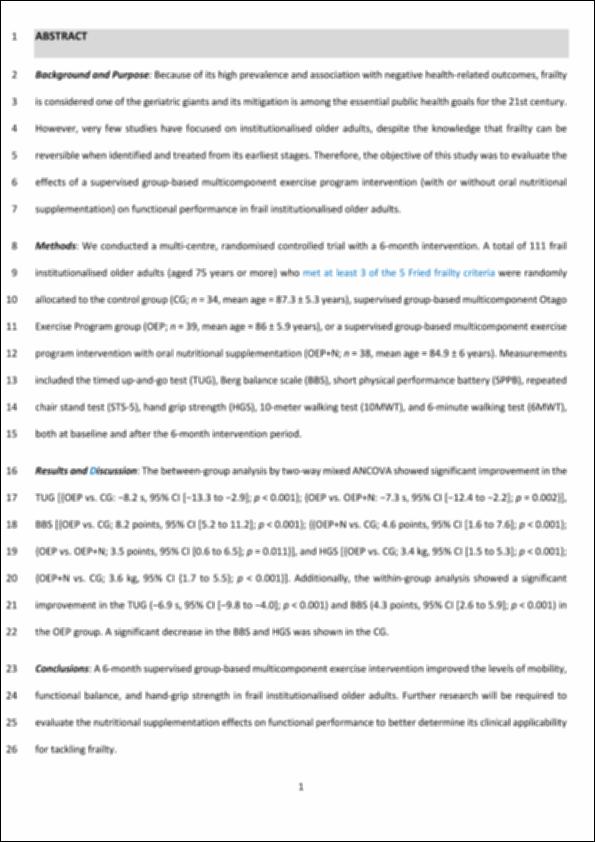Por favor, use este identificador para citar o enlazar este ítem:
http://hdl.handle.net/10637/15006Effectiveness of a supervised group-based Otago Exercise Program on functional performance in frail institutionalized older adults: a multicenter randomized controlled trial

Ver/Abrir:
Effectiveness_Garcia_JGPT_2023_postprint.pdf
353,73 kB
Adobe PDF
Ver/Abrir:
Effectiveness_Garcia_JGPT_2023.pdf
Acceso restringido
1,65 MB
Adobe PDF
Request a copy
| Título : | Effectiveness of a supervised group-based Otago Exercise Program on functional performance in frail institutionalized older adults: a multicenter randomized controlled trial |
| Autor : | García Gollarte, Fermín Mora Concepción, Ania Pinazo Hernandis, Sacramento Segura Ortí, Eva Amer Cuenca, Juan José Arguisuelas Martínez, María Dolores Lisón Párraga, Juan Francisco Benavent Caballer, Vicente |
| Materias: | Educación física; Physical education; Anciano; Elderly; Fisioterapia; Physical therapy; Nutrición; Nutrition |
| Editorial : | Wolters Kluwer Academy of Geriatric Physical Therapy |
| Citación : | García-Gollarte, F., Mora-Concepción, A., Pinazo-Hernandis, S., Segura-Ortí, E., Amer-Cuenca, J.J., Arguisuelas-Martínez, M.D., Lisón, J.F. & Benavent-Caballer, V. (2023). Effectiveness of a supervised group-based Otago Exercise Program on functional performance in frail institutionalized older adults: a multicenter randomized controlled trial. Journal of Geriatric Physical Therapy, vol. 46, i. 1 (jan.-mar.), pp. 15–25. DOI: https://doi.org/10.1519/JPT.0000000000000326 |
| Resumen : | Background and purpose: Because of its high prevalence and association with negative health-related outcomes, frailty is considered one of the most important issues associated with human aging and its mitigation is among the essential public health goals for the 21st century. However, very few studies have focused on institutionalized older adults, despite the knowledge that frailty can be reversible when identified and treated from its earliest stages. Therefore, the objective of this study was to evaluate the effects of a supervised group-based multicomponent exercise program intervention with or without oral nutritional supplementation on functional performance in frail institutionalized older adults. Methods: This was a multicenter randomized controlled trial study with a 6-month intervention period. A total of 111 frail institutionalized older adults (75 years or older) who met at least 3 of the 5 Fried frailty criteria were randomly allocated to the control group (CG; n = 34, mean age = 87.3 ± 5.3 years), a supervised group-based multicomponent Otago Exercise Program group (OEP; n = 39, mean age = 86 ± 5.9 years), or a supervised group-based multicomponent exercise program intervention with oral nutritional supplementation (OEP+N; n = 38, mean age = 84.9 ± 6 years). Measurements included the Timed Up and Go test (TUG), Berg Balance Scale (BBS), Short Physical Performance Battery, repeated chair stand test (STS-5), handgrip strength (HGS), 10-m walking test, and 6-minute walking test, both at baseline and after the 6-month intervention period. Results and discussion: The between-group analysis by 2-way analysis of covariance showed significant improvement in the TUG [{OEP vs CG: -8.2 seconds, 95% CI [-13.3 to -2.9]; P < .001}; {OEP vs OEP+N: -7.3 seconds, 95% CI [-12.4 to -2.2]; P = .002}], BBS [{OEP vs CG; 8.2 points, 95% CI [5.2 to 11.2]; P < .001}; [{OEP+N vs CG: 4.6 points, 95% CI [1.6 to 7.6]; P < .001}; {OEP vs OEP+N: 3.5 points, 95% CI [0.6 to 6.5]; P = .011}], and HGS [{OEP vs CG: 3.4 kg, 95% CI [1.5 to 5.3]; P < .001}; {OEP+N vs CG: 3.6 kg, 95% CI [1.7 to 5.5]; P < .001}]. Additionally, the within-group analysis showed a significant improvement in the TUG (-6.9 seconds, 95% CI [-9.8 to -4.0]; P < .001) and BBS (4.3 points, 95% CI [2.6 to 5.9]; P < .001) in the OEP group. A significant decrease in the BBS and HGS was shown in the CG. Conclusions: A 6-month supervised group-based multicomponent exercise intervention improved the levels of mobility, functional balance, and HGS in frail institutionalized older adults. Further research will be required to evaluate the nutritional supplementation effects on functional performance to better determine its clinical applicability for tackling frailty. |
| Descripción : | Este artículo es la versión postprint, siguiendo la política de acceso de Wolters Kluwer. Este es el post-print del siguiente artículo: García-Gollarte, F., Mora-Concepción, A., Pinazo-Hernandis, S., Segura-Ortí, E., Amer-Cuenca, J.J., Arguisuelas-Martínez, M.D., Lisón, J.F. & Benavent-Caballer, V. (2023). Effectiveness of a supervised group-based Otago Exercise Program on functional performance in frail institutionalized older adults: a multicenter randomized controlled trial. Journal of Geriatric Physical Therapy, vol. 46, i. 1 (jan.-mar.), pp. 15–25, que se ha publicado de forma definitiva en: https://doi.org/10.1519/JPT.0000000000000326 This is the peer reviewed version of the following article:García-Gollarte, F., Mora-Concepción, A., Pinazo-Hernandis, S., Segura-Ortí, E., Amer-Cuenca, J.J., Arguisuelas-Martínez, M.D., Lisón, J.F. & Benavent-Caballer, V. (2023). Effectiveness of a supervised group-based Otago Exercise Program on functional performance in frail institutionalized older adults: a multicenter randomized controlled trial. Journal of Geriatric Physical Therapy, vol. 46, i. 1 (jan.-mar.), pp. 15–25, which has been published in final form at: https://doi.org/10.1519/JPT.0000000000000326 |
| URI : | http://hdl.handle.net/10637/15006 |
| Derechos: | http://creativecommons.org/licenses/by-nc-nd/4.0/deed.es |
| ISSN : | 1539-8412 2152-0895 (Electrónico) |
| Fecha de publicación : | ene-2023 |
| Centro : | Universidad Cardenal Herrera-CEU |
| Aparece en las colecciones: | Dpto. Enfermería y Fisioterapia |
Los ítems de DSpace están protegidos por copyright, con todos los derechos reservados, a menos que se indique lo contrario.

